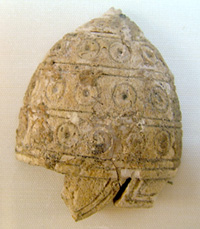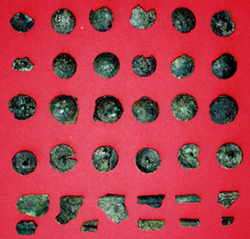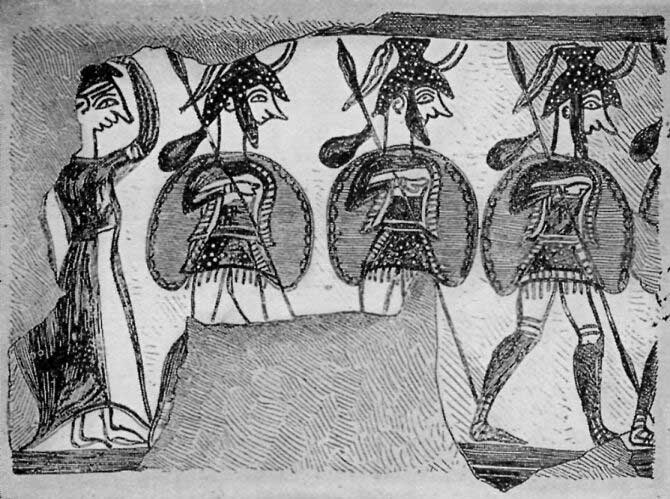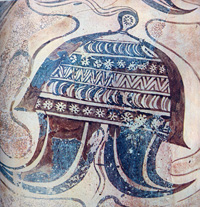 |
| That picture again. |
The Phaistos helmet has circular markings with little holes in the middle at regular intervals around the outside. These are reinforcement discs, or o-pa-wo-ta in Linear B (έπαϝορτα) . It means "attachments", and we know from Linear B archives that o-pa-wo-ta were used on both helmets and body armour to enhance the protective qualities of perishable materials such as leather and linen. O-pa-wo-ta were made of bronze (possibly ivory or bone in some cases), and they gave extra protection against arrows and sword blows. Very few bronze age helmets were made entirely of metal, but metal reinforcement pieces were a common design element right through the bronze age. The Phaistos relief would have had metal discs that unfortunately haven't survived, and they would have been shaped like little nails with pins driven into the holes in the ivory piece.
Reinforcement pieces on real helmets were either metal studs with pins that were hammered through the leather, or perforated discs stitched to the leather. Archaeological evidence suggest both types were used, but for this project I'm going with metal studs similar to these late bronze age examples found at Lakkithra, which have a round, slightly domed head with a pin in the center.
 |
| Small bronze nails used to reinforce a helmet, found at Lakkithra. |
Bronze age art indicates o-pa-wo-ta came in all sizes, from relatively large ones on the Phaistos relief to tiny ones that look more like studs on a leather jacket on the Warrior Vase from Mycenae, made around 1200 BCE. The white dots on these helmets represent o-pa-wo-ta. Bearing in mind the fact that o-pa-wo-ta could also be used on body armour, the white dots on the warriors' kilts may also represent o-pa-wo-ta.
 |
| Picture found here. |
These small o-pa-wo-ta scattered randomly over the surface of the helmet are a bit unusual. Most depictions of bronze age helmets show the o-pa-wo-ta arranged in horizontal rows.
I should point out here that the circular markings on the Phaistos relief don't necessarily indicate what shape the metal discs were. It's quite possible they were round with a small circle in the middle, but they may not have been. Other art works suggest plain round discs like the ones from Lakkithra and some clearly show o-pa-wo-ta shaped like rosettes, which is why I was quite excited when I found some studs in the shape of little rosettes.
Those are furniture tacks. They were described as "bronze" on the Ebay listing, but of course that refers to the colour. I doubt they are actually bronze, but they do look about right. As you can see they're a lot like the Lakkithra studs, apart from the embossed rosettes. They have the same slightly domed head and central pin. Even though they aren't quite the right metal, I'm very pleased with them.
Studs in the shape of rosettes are shown on some pictures of helmets from this time, and rosettes in general were a common design in Minoan and Mycenaean art. Many were very similar to the rosettes on my furniture tacks.
 |
| A Minoan helmet with rosette-shaped studs and what appear to be rows of boar tusks. |
References for the Linear B tablets:
Chadwick, J., Killen, J. T., Olivier, J.P. 1971. The Knossos Tablets (4th Edition). Cambridge: Cambridge University Press.
Ventris, M., Chadwick, J. 1956. Documents in Mycenaean Greek. Cambridge: Cambridge University Press.

Those furniture tacks look great! I think they will give an excellent Bronze Age effect on your helmet.
ReplyDeleteThanks! They're all hammered in now, and you're absolutely right - they do make it look so much more Bronze Age.
Delete